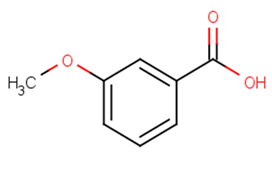
3-Methoxybenzoic acid
CAS No. 586-38-9
3-Methoxybenzoic acid( 3-Anisic acid | 3-Methoxybenzoic acid | NSC 27014 | NSC 9264 | m-Methoxybenzoic acid )
Catalog No. M20595 CAS No. 586-38-9
3-methoxybenzoic acid is a food additiveand has antibacterial activity.
Purity : >98% (HPLC)
 COA
COA
 Datasheet
Datasheet
 HNMR
HNMR
 HPLC
HPLC
 MSDS
MSDS
 Handing Instructions
Handing Instructions
| Size | Price / USD | Stock | Quantity |
| 500MG | 38 | In Stock |


|
| 1G | Get Quote | In Stock |


|
Biological Information
-
Product Name3-Methoxybenzoic acid
-
NoteResearch use only, not for human use.
-
Brief Description3-methoxybenzoic acid is a food additiveand has antibacterial activity.
-
Description3-methoxybenzoic acid is a food additiveand has antibacterial activity.
-
In Vitro——
-
In Vivo——
-
Synonyms3-Anisic acid | 3-Methoxybenzoic acid | NSC 27014 | NSC 9264 | m-Methoxybenzoic acid
-
PathwayProteasome/Ubiquitin
-
TargetEndogenous Metabolite
-
RecptorHuman Endogenous Metabolite
-
Research Area——
-
Indication——
Chemical Information
-
CAS Number586-38-9
-
Formula Weight152.15
-
Molecular FormulaC8H8O3
-
Purity>98% (HPLC)
-
SolubilityDMSO:30 mg/mL (197.17 mM)
-
SMILESCOc1cccc(c1)C(O)=O
-
Chemical Name——
Shipping & Storage Information
-
Storage(-20℃)
-
ShippingWith Ice Pack
-
Stability≥ 2 years
Reference
1.Popio?Ek ? Biernasiuk A . Hydrazide-hydrazones of 3-methoxybenzoic acid and 4-\r?tert\r -butylbenzoic acid with promising antibacterial activity against\r?Bacillus\r spp[J]. Journal of Enzyme Inhibition and Medicinal Chemistry 2016:1-8.
molnova catalog



related products
-
14-Diaminobutane
14-Diaminobutane is a GABA precursor in many biological systems and synthon for amido-ureas.
-
2-Picolinic acid
PCL 016 is a topical antiviral agent which inhibits adenovirus replication in rabbit.
-
(S)-(?)-Limonene
(S)-(?)-Limonene is a Monoterpenoidsit can induce a mild bronchoconstrictive effect.



 Cart
Cart
 sales@molnova.com
sales@molnova.com


